BCHP 6 (Ruin of Esagila Chronicle)
The Babylonian Ruin of Esagila chronicle (BCHP 6) is a chronicle written in ancient Babylonia in the Hellenistic Period. It describes how a Seleucid crown prince (probably Antiochus, the son of king Seleucus Nicator) fell during a sacrifice on the ruin of Esagila.
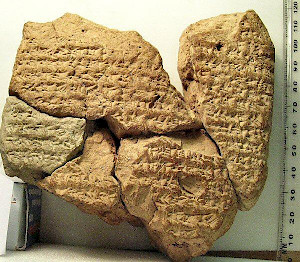
The Babylonian Ruin of Esagila chronicle (BCHP 6) is one of the Mesopotamian chronicles written in ancient Babylonia in the Hellenistic Period. It describes how a Seleucid crown prince (probably Antiochus, the son of king Seleucus Nicator) fell during a sacrifice on the ruin of Esagila. The cuneiform tablets (BM 32248 + 32456 + 32477 + 32543 + 76-11-17 unnumbered) are in the British Museum.
On this webpage, a new reading is proposed; the official publication will be in I.L. Finkel, R.J. van der Spek, R. Pirngruber, Babylonian Chronographic Texts from the Hellenistic Period (2020; = BCHP; Writings of the Ancient World).
Description of the tablet
The present state of the tablet is made up of five fragments, joined by Irving Finkel. The left and right edges are preserved and measure ca. 2.5 cm thickness. The width of the tablet is 10 cm. and the lines contain ca. 14-18 signs. The broken upper edge measures 4 cm, the lower 2.8 cm, which indicates that possibly the upper half of the tablet is lost, and that not much is missing from the bottom end. The length of the tablet, as preserved, is 11 cm.
The tablet in question is really a strange tablet in various respects. The tablet looks like a chronicle, but the reverse lines 3’ff look more like the minutes of a court proceeding. The tablet is very clumsily written with crude, large and badly written signs. It may have been a school text or a draft note of events of two years, later to be used for a real chronicle or to be inserted in an Astronomical Diary.
No date is preserved, nor a royal name. The crown prince (DUMU LUGAL, mar šarri), however, is most likely Antiochus, son of Seleucus I Nicator. The addition (šá bît redûti), made in the Antiochus and Sin Chronicle (= BCHP 5), is not used in the preserved part of this tablet, so the tablet may be dated between the period ca. 302 BCE (when the first elephants arrived from India) and 281, when Seleucus I was killed. It seems most likely, however, that the tablet dates to the time after 293 BCE, when Antiochus was appointed co-ruler with his father, with special authority in the eastern part of the empire, i.e. east of the Euphrates. Antiochus spent much of his time in Babylon and the chronicles testify his activities.
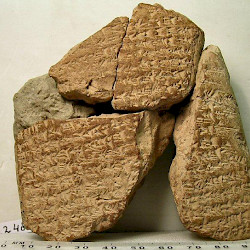 BCHP 06 Ruin Esagila (BM32248), Reverse |
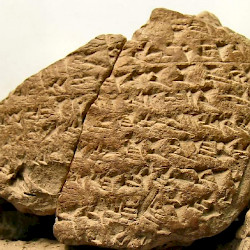 BCHP 06 Ruin Esagila (BM32248), Reverse, fragment |
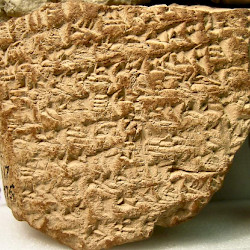 BCHP 06 Ruin Esagila (BM32248), Reverse, fragment |
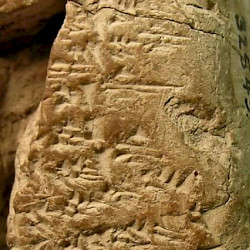 BCHP 06 Ruin Esagila (BM32248), Reverse, fragment |
Introduction to this chronicle
The obverse describes activities of crown prince Antiochus I concerning the restoration of Esagila. Etemenanki has been in state of delapidation since the Persian period, perhaps since Xerxes. Alexander the Great ordered the removal of the remnants of the temple tower in order to restore it. After Alexander’s death this work continued. A royal inscription of Antiochus I records the repairs of Esagila and Ezida, which are supposed to have started on 20 Addaru 43 SE = 27 March, 268 BCE.note
Translation obverse
[Obv.1'] [.. .. .. .. .. .. .. .. .. .. .. .. .. .. .. ..] .. .. [(..)]
[Obv.2'] [.. .. .. .. .. .. .. .. .. .. .. .. .. .. .. ..] to Babylon
[Obv.3'] wi[th?? .. .. .. .. .. .. .. .. .. .. .. ..] .. .. of Bel
[Obv.4'] to the Bab[ylon]ians (of) [the assembly of Esa]gila he [gav]e and an offering
[Obv.5'] on the ruin of /Esagila\ they?! [arran]ged. On the ruin
[Obv.6'] of Esagila he fell.note Oxen [and ] an offering in the Greek fashion
[Obv.7'] he made. The son of the king, his [troop]s, his wagons,
[Obv.8'] (and) <his> elephants removed the debris of Esagila.
[Obv.9'] /x x\ on the empty lot of Esagila they ate. That [month], 17? day,
[Obv.10'] a stroke of lightning /within Eridu\ against the x [building] in the middle of its roof took place.
[Obv.11'] Month Simanu (III). Th[at] month [ .. .. .. .. .. ..] x [.. .. ..]x the Tigris
[Obv.12'] he crossed and he said to go to [.. .. .. .. ..]. He went, (but) he returned.
[Obv.13'] [Mo]nth Ululu (VI). That month, [Gre]eks at the command of the king to [.. .. ]
[Obv.14'] [... Esa]gila, Ezid[a] /E?\.mez?la[m?, san]ctuaries x [.. ..]
[Obv.15'] [.. .. ..]x Month Addaru (XII). [That] month, the Babylonians[ .. ..]
[Obv.16'] [.. .. .. .. .. .. .. ..] Babylonians x[.. .. ..]
[Obv.17'] [.. .. .. .. .. .. .. ..] .. .. .. [.. .. ..]
[Broken off (3 lines missing ?).]
Translation reverse
[Rev] [The reverse is very difficult to read and defies a reasonable translation. The section starting with line 3’ deals with a serious conflict. Somebody may have been arrested in order to be put to death. The son of the king seems to intend to release him, but another man tries to prevent that by denouncing him, apparently in fear of the fact that the person to be released will in turn denounce the denouncer. The charge had something to do with workmen who did not do their job correctly and the question seems to be: who is responsible? The son of the king is invited to take a look himself. It may perhaps have to do with problems with the workmen working on the restoration of Esagila and Ezida mentioned on the obverse. Perhaps there was some sabotage.]